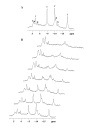Decrease in oxidative phosphorylation yield in presence of butyrate in perfused liver isolated from fed rats
- PMID: 17725817
- PMCID: PMC2048500
- DOI: 10.1186/1472-6793-7-8
Decrease in oxidative phosphorylation yield in presence of butyrate in perfused liver isolated from fed rats
Abstract
Background: Butyrate is the main nutrient for the colonocytes but the effect of the fraction reaching the liver is not totally known. A decrease in tissue ATP content and increase in respiration was previously demonstrated when livers were perfused with short-chain fatty acids (SCFA) such as butyrate, or octanoate. In fed rats the oxidative phosphorylation yield was determined on the whole isolated liver perfused with butyrate in comparison with acetate and octoanoate (3 mmol/L). The rate of ATP synthesis was determined in the steady state by monitoring the rate of ATP loss after inhibition of (i) cytochrome oxidase (oxidative phosphorylation) with KCN (2.5 mmol/L) and (ii) glyceraldehyde 3-phosphate dehydrogenase (glycolysis) with IAA (0.5 mmol/L). The ATP flux, estimated by 31P Nuclear Magnetic Resonance, and the measured liver respiration allowed the ATP/O ratio to be determined.
Results: ATP turnover was significantly lower in the presence of butyrate (0.40 +/- 0.10 micromoles/min.g, p = 0.001, n = 7) and octanoate (0.56 +/- 0.10 micromoles/min.g, p = 0.01, n = 5) than in control (1.09 +/- 0.13 micromoles/min.g, n = 7), whereas perfusion with acetate induced no significant decrease (0.76 +/- 0.10 micromoles/min.g, n = 7). Mitochondrial oxygen consumption was unchanged in the presence of acetate (1.92 +/- 0.16 vs 1.86 +/- 0.16 for control) and significantly increased in the presence of butyrate (p = 0.02) and octanoate (p = 0.0004) (2.54 +/- 0.18 and 3.04 +/- 0.15 micromoles/min.g, respectively). The oxidative phosphorylation yield (ATP/O ratio) calculated in the whole liver was significantly lower with butyrate (0.07 +/- 0.02, p = 0.0006) and octanoate (0.09 +/- 0.02, p = 0.005) than in control (0.30 +/- 0.05), whereas there was no significant change with acetate (0.20 +/- 0.02).
Conclusion: Butyrate or octanoate decrease rather than increase the rate of ATP synthesis, resulting in a decrease in the apparent ATP/O ratio. Butyrate as a nutrient has the same effect as longer chain FA. An effect on the hepatic metabolism should be taken into account when large quantities of SCFA are directly used or obtained during therapeutic or nutritional strategies.
Figures


Similar articles
-
Butyrate ingestion improves hepatic glycogen storage in the re-fed rat.BMC Physiol. 2008 Oct 10;8:19. doi: 10.1186/1472-6793-8-19. BMC Physiol. 2008. PMID: 18847460 Free PMC article.
-
Butyrate impairs energy metabolism in isolated perfused liver of fed rats.J Nutr. 2001 Jul;131(7):1986-92. doi: 10.1093/jn/131.7.1986. J Nutr. 2001. PMID: 11435518
-
Ethanol perfusion increases the yield of oxidative phosphorylation in isolated liver of fed rats.Biochim Biophys Acta. 2002 Mar 15;1570(2):135-40. doi: 10.1016/s0304-4165(02)00187-3. Biochim Biophys Acta. 2002. PMID: 11985898
-
Resveratrol mainly stimulates the glycolytic ATP synthesis flux and not the mitochondrial one: a saturation transfer NMR study in perfused and isolated rat liver.Pharmacol Res. 2013 Dec;78:11-7. doi: 10.1016/j.phrs.2013.09.007. Epub 2013 Oct 1. Pharmacol Res. 2013. PMID: 24090928
-
Flux-force relationships in intact cells: a helpful tool for understanding the mechanism of oxidative phosphorylation alterations?Biochim Biophys Acta. 1998 Jun 10;1365(1-2):117-24. doi: 10.1016/s0005-2728(98)00051-6. Biochim Biophys Acta. 1998. PMID: 9693730 Review.
Cited by
-
Butyrate ingestion improves hepatic glycogen storage in the re-fed rat.BMC Physiol. 2008 Oct 10;8:19. doi: 10.1186/1472-6793-8-19. BMC Physiol. 2008. PMID: 18847460 Free PMC article.
-
Butyrate to combat obesity and obesity-associated metabolic disorders: Current status and future implications for therapeutic use.Obes Rev. 2022 Oct;23(10):e13498. doi: 10.1111/obr.13498. Epub 2022 Jul 20. Obes Rev. 2022. PMID: 35856338 Free PMC article. Review.
-
Effects of Sodium Butyrate Treatment on Histone Modifications and the Expression of Genes Related to Epigenetic Regulatory Mechanisms and Immune Response in European Sea Bass (Dicentrarchus Labrax) Fed a Plant-Based Diet.PLoS One. 2016 Jul 29;11(7):e0160332. doi: 10.1371/journal.pone.0160332. eCollection 2016. PLoS One. 2016. PMID: 27471849 Free PMC article.
-
Recent Advances in the Pathophysiology of Fatty Acid Oxidation Defects: Secondary Alterations of Bioenergetics and Mitochondrial Calcium Homeostasis Caused by the Accumulating Fatty Acids.Front Genet. 2020 Nov 27;11:598976. doi: 10.3389/fgene.2020.598976. eCollection 2020. Front Genet. 2020. PMID: 33329744 Free PMC article. Review.
-
Short- and medium-chain fatty acids in energy metabolism: the cellular perspective.J Lipid Res. 2016 Jun;57(6):943-54. doi: 10.1194/jlr.R067629. Epub 2016 Apr 14. J Lipid Res. 2016. PMID: 27080715 Free PMC article. Review.
References
-
- Beauvieux MC, Tissier P, Gin H, Canioni P, Gallis JL. Butyrate impairs energy metabolism in isolated perfused liver of fed rats. J Nutr. 2001;131:1986–1992. - PubMed
-
- Royall D, Wolever TM, Jeejeebhoy KN. Clinical significance of colonic fermentation. Am J Gastroenterol. 1990;85:1307–1312. - PubMed
-
- Rapport Glucides et Santé . Etat des lieux, évaluation et recommandations. Agence Française de Sécurité Sanitaire des Aliments, Maisons-Alfort: AFSSA; 2004.
Publication types
MeSH terms
Substances
LinkOut - more resources
Full Text Sources
Other Literature Sources
Research Materials

